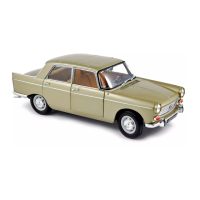I
Key
to Fig 7 :4 3 Plate
4 Washer 5 lmpact installel
4 Remove the wheel
shaft,
using
a suitable
puller
fixed
to the three
wheel attachment
studs
(see
FIG 7 :6).
BeÍore reinstalling the
shaÍt,
smear
the
bearing faces
of
the flange
and axle tube
with sealing
paste.
With the
shaft
in
position,
tighten the nuts
of the Ílange
to a torque
oÍ
7.23
to
10.8
lb ft.
7:6 Diagnosing rear
axle
faults
Due to the special tooling and
gauging
required Íor the
reassembly
of
the rear
axle
it is not
advised that the
assembly
should be
stripped.
Much can
be learned
by
observing
symptoms
during the
operation
of the car. The
most common
rear
axle complaint is
noise.
Care
must
be
taken
to ensure that
the noise is not
caused
by the engine,
transmission, tyres,
wheel bearings
or some other
part
of the car.
BeÍore
road testing the
car ensure that there is
sufÍicient
lubricant
in the axle housing
and inflate the
tyres to
the correct
pressures.
Drive
the car Íar enough
to warm the lubricant to its
normal operating temperature
before
making the ïests.
P404
Engine or exhaust noise
can be detected by running
the engine at
various
speeds with the car
parked
and
the
transmission in neutral.
Tyre noise can be detected by running the
car over
various road
surfaces. Tyre noise is
minimized on a
smooth
asphalt surface,
Changing
the
wheels
around
can help
to detect or eliminate tyre noises.
Wheel
bearing noise can
often
be detected by
jacking
up the
car and
feeling for
roughness when the wheel is
rotated. Wheel bearing noise is most
obvious whe'n
coasting at low speed, and applying
the brakes lightly
while the
car is
moving
will oÍten reduce
or eliminate
the noise
of a defective
bearing.
When all the
above conditions
have
been eliminated
test the car for
axle
noise
under
the
following conditions:
1 Drive:
Gradual acceleration on a level road.
2 Cruise: Constant
speed operation at normal road
speed.
3
Float:
Use only enough throttle to keep the
car Írom
driving the engine.
4 Coast: Throttle
closed with engine braking the
car.
Backlash
or
play
in the
running
gear
can be checked
by driving the car
on
a
smooth
road
at
25
mile/hr and
lightly
pressing
and releasing the accelerator
pedal.
Backlash
is
indicated
by a slapping noise with
each
movement
oÍ
the
accelerator
pedal.
Raising the
car on a
ramp
will
enable a more detailed
examination to be made.
7 :7
Rear suspension
The rear
suspension
comprises coil
springs
and
teles-
copic
shock
absorbers. The
coil springs are
mounted
directly on the
axle
tube
and are
inclined
slightly
to the
Installing
the bearing
Cutawav view
of the rear axre
FIG 7:6 Removing
the rear axle
shaÍt
FIG
7 :7 Plan
view
showing suspension arrangement
67

